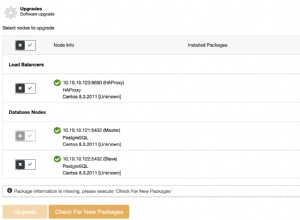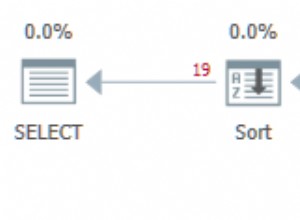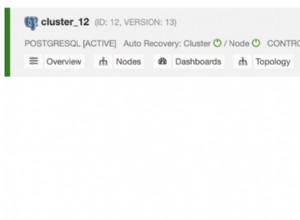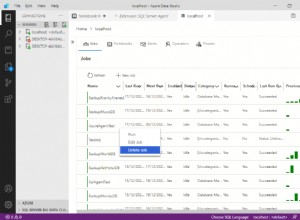Opcja 1
Jest to prawdopodobnie zadanie dla PL/SQL. Zaczynając od typów danych do wyprowadzenia:
CREATE TYPE supply_details_obj AS OBJECT(
product_id NUMBER,
quantity NUMBER,
supplier_id NUMBER,
customer_id NUMBER
);
CREATE TYPE supply_details_tab AS TABLE OF supply_details_obj;
Następnie możemy zdefiniować funkcję potokową, która odczyta INVENTORY_IN i INVENTORY_OUT tabele po jednym wierszu na raz i połącz je, zachowując bieżącą sumę pozostałych zapasów lub ilości do dostarczenia:
CREATE FUNCTION assign_suppliers_to_customers (
i_product_id IN INVENTORY_IN.PRODUCT_ID%TYPE
)
RETURN supply_details_tab PIPELINED
IS
v_supplier_id INVENTORY_IN.SUPPLIER_ID%TYPE;
v_customer_id INVENTORY_OUT.CUSTOMER_ID%TYPE;
v_quantity_in INVENTORY_IN.IN_QUANTITY%TYPE := NULL;
v_quantity_out INVENTORY_OUT.OUT_QUANTITY%TYPE := NULL;
v_cur_in SYS_REFCURSOR;
v_cur_out SYS_REFCURSOR;
BEGIN
OPEN v_cur_in FOR
SELECT in_quantity, supplier_id
FROM INVENTORY_IN
WHERE product_id = i_product_id
ORDER BY inv_timestamp;
OPEN v_cur_out FOR
SELECT out_quantity, customer_id
FROM INVENTORY_OUT
WHERE product_id = i_product_id
ORDER BY inv_timestamp;
LOOP
IF v_quantity_in IS NULL THEN
FETCH v_cur_in INTO v_quantity_in, v_supplier_id;
IF v_cur_in%NOTFOUND THEN
v_supplier_id := NULL;
END IF;
END IF;
IF v_quantity_out IS NULL THEN
FETCH v_cur_out INTO v_quantity_out, v_customer_id;
IF v_cur_out%NOTFOUND THEN
v_customer_id := NULL;
END IF;
END IF;
EXIT WHEN v_cur_in%NOTFOUND AND v_cur_out%NOTFOUND;
IF v_quantity_in > v_quantity_out THEN
PIPE ROW(
supply_details_obj(
i_product_id,
v_quantity_out,
v_supplier_id,
v_customer_id
)
);
v_quantity_in := v_quantity_in - v_quantity_out;
v_quantity_out := NULL;
ELSE
PIPE ROW(
supply_details_obj(
i_product_id,
v_quantity_in,
v_supplier_id,
v_customer_id
)
);
v_quantity_out := v_quantity_out - v_quantity_in;
v_quantity_in := NULL;
END IF;
END LOOP;
END;
/
Następnie dla przykładowych danych:
CREATE TABLE INVENTORY_IN ( ID, INV_TIMESTAMP, PRODUCT_ID, IN_QUANTITY, SUPPLIER_ID ) AS
SELECT 0, TIMESTAMP '2021-03-09 00:00:00', 101, 20, 0 FROM DUAL UNION ALL
SELECT 1, TIMESTAMP '2021-03-10 01:00:00', 101, 100, 4 FROM DUAL UNION ALL
SELECT 2, TIMESTAMP '2021-03-11 02:00:00', 101, 50, 3 FROM DUAL UNION ALL
SELECT 3, TIMESTAMP '2021-03-14 01:00:00', 101, 10, 2 FROM DUAL;
CREATE TABLE INVENTORY_OUT ( ID, INV_TIMESTAMP, PRODUCT_ID, OUT_QUANTITY, CUSTOMER_ID ) AS
SELECT 1, TIMESTAMP '2021-03-10 02:00:00', 101, 30, 1 FROM DUAL UNION ALL
SELECT 2, TIMESTAMP '2021-03-11 01:00:00', 101, 40, 2 FROM DUAL UNION ALL
SELECT 3, TIMESTAMP '2021-03-12 01:00:00', 101, 80, 1 FROM DUAL;
Zapytanie:
SELECT product_id,
supplier_id,
customer_id,
SUM( quantity ) AS quantity
FROM TABLE( assign_suppliers_to_customers( 101 ) )
GROUP BY
product_id,
supplier_id,
customer_id
ORDER BY
MIN( inv_timestamp )
Wyjścia:
Opcja 2
(Bardzo) skomplikowane zapytanie SQL:
WITH in_totals ( ID, INV_TIMESTAMP, PRODUCT_ID, IN_QUANTITY, SUPPLIER_ID, TOTAL_QUANTITY ) AS (
SELECT i.*,
SUM( in_quantity ) OVER ( PARTITION BY product_id ORDER BY inv_timestamp )
FROM inventory_in i
),
out_totals ( ID, INV_TIMESTAMP, PRODUCT_ID, OUT_QUANTITY, CUSTOMER_ID, TOTAL_QUANTITY ) AS (
SELECT o.*,
SUM( out_quantity ) OVER ( PARTITION BY product_id ORDER BY inv_timestamp )
FROM inventory_out o
),
split_totals ( product_id, inv_timestamp, supplier_id, customer_id, quantity ) AS (
SELECT i.product_id,
MIN( COALESCE( LEAST( i.inv_timestamp, o.inv_timestamp ), i.inv_timestamp ) )
AS inv_timestamp,
i.supplier_id,
o.customer_id,
SUM(
COALESCE(
LEAST(
i.total_quantity - o.total_quantity + o.out_quantity,
o.total_quantity - i.total_quantity + i.in_quantity,
i.in_quantity,
o.out_quantity
),
0
)
)
FROM in_totals i
LEFT OUTER JOIN
out_totals o
ON ( i.product_id = o.product_id
AND i.total_quantity - i.in_quantity <= o.total_quantity
AND i.total_quantity >= o.total_quantity - o.out_quantity )
GROUP BY
i.product_id,
i.supplier_id,
o.customer_id
ORDER BY
inv_timestamp
),
missing_totals ( product_id, inv_timestamp, supplier_id, customer_id, quantity ) AS (
SELECT i.product_id,
i.inv_timestamp,
i.supplier_id,
NULL,
i.in_quantity - COALESCE( s.quantity, 0 )
FROM inventory_in i
INNER JOIN (
SELECT product_id,
supplier_id,
SUM( quantity ) AS quantity
FROM split_totals
GROUP BY product_id, supplier_id
) s
ON ( i.product_id = s.product_id
AND i.supplier_id = s.supplier_id )
ORDER BY i.inv_timestamp
)
SELECT product_id, supplier_id, customer_id, quantity
FROM (
SELECT product_id, inv_timestamp, supplier_id, customer_id, quantity
FROM split_totals
WHERE quantity > 0
UNION ALL
SELECT product_id, inv_timestamp, supplier_id, customer_id, quantity
FROM missing_totals
WHERE quantity > 0
ORDER BY inv_timestamp
);
Co dla przykładowych danych powyżej daje:
db<>fiddle tutaj




